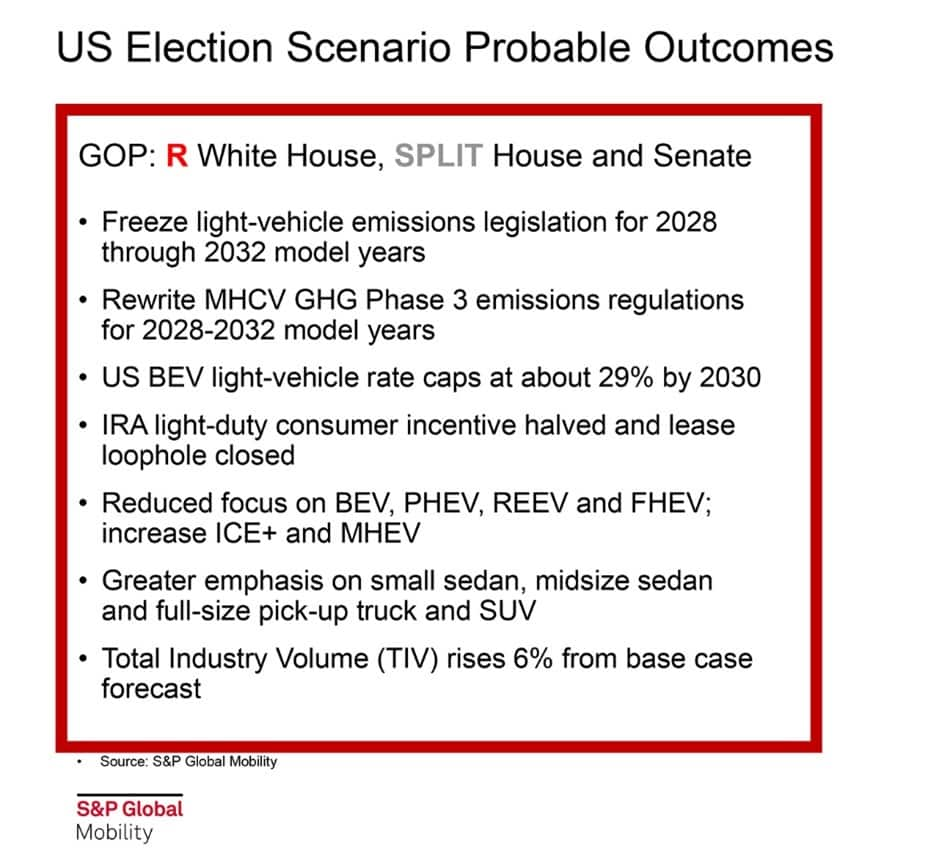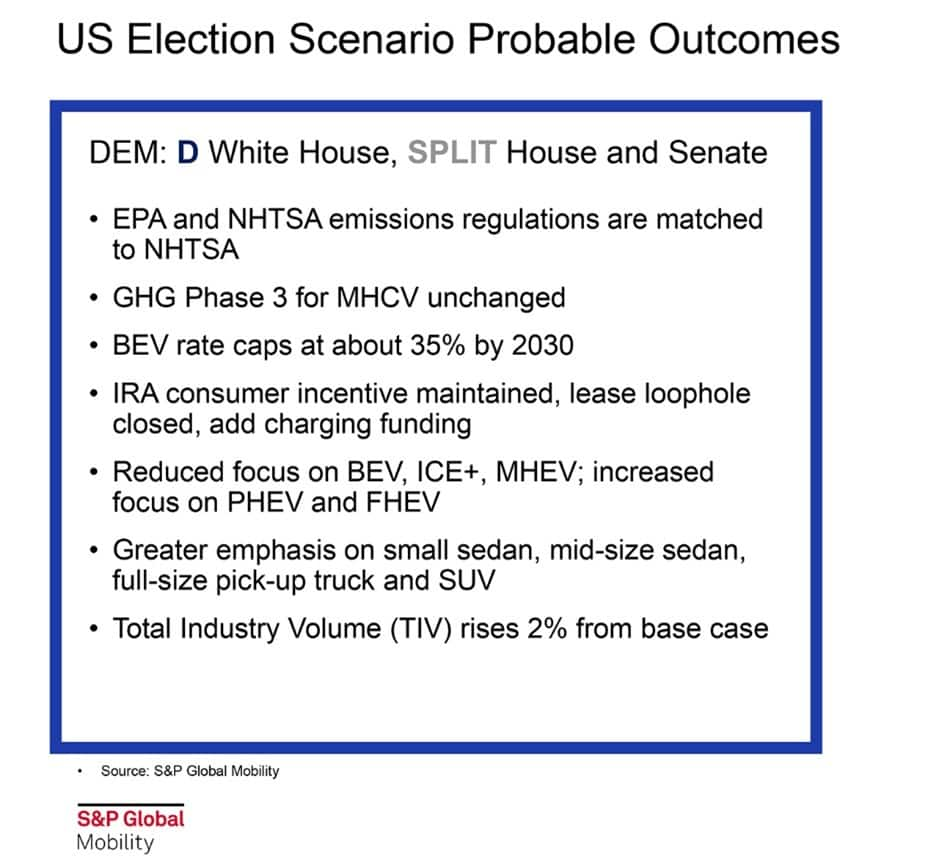Customer Logins
Obtain the data you need to make the most informed decisions by accessing our extensive portfolio of information, analytics, and expertise. Sign in to the product or service center of your choice.
Customer LoginsFuel for Thought: 2024 Presidential Election: Impacts on the US Auto Industry
Read our updated analysis - 7 November 2024
This Fuel for Thought edition offers an excerpt from our new special report, 2024 US election and the automotive ecosystem: How much change to expect?
One of the most impactful presidential elections in United States history is scheduled for November 5, 2024. Regardless of the outcome, the following issues are expected to directly affect the US auto industry:
- The perception of an existential threat from mainland Chinese automakers and technology companies;
- Positions on environmental policy, particularly as relates to vehicle emissions and safety regulations;
- Trade policy as it relates to both USMCA and potential for national security tariffs; and
- Positions relative to unions and labor.
At S&P Global Mobility, we're looking at every possible scenario and how various outcomes may change (or not change) the bigger picture for the auto industry.
It is important to note that policy changes will not be immediate and could take most of the next presidency to execute. Even after the election, the trajectory of the new administration and their focus will not be known until early- to mid-2025.
We expect many companies are likely holding major decisions until after the makeup of the White House cabinet and advisors becomes clearer, as well as taking time to understand the impact of the Congressional and state elections.
As an example, Republicans are vocal about wanting to reduce funding for the federal programs under the Inflation Reduction Act. Some states with automotive industrial investment vote Republican and others vote Democrat. House and Senate representatives from those states have a stake in maintaining an inviting economic environment for the district or state they represent as well as loyalty to party affiliation. The outcome can cause voting along party lines which may conflict with constituent priorities, and vice versa.
In our new special report, we detail several scenarios and how we see they may unfold from a policy perspective. For anyone with a stake in the industry, shifting to a scenario mindset becomes critical for decision-making. A single forecast is only one guideline. Critical decisions need to consider business and market demand issues in the context of upper and lower bounds derived from plausible scenarios, along with a baseline forecast.
Potential policy changes, depending on the scenario, include:
- 2028+ federal emissions and fuel economy regulations
- Inflation Reduction Act funding future
- Mainland China sourcing tariffs
- California: Does its ability to regulate emissions continue?
- 2026 USMCA Review
Most Likely Outcomes
There are four principal outcomes for the election itself. S&P Global Mobility does not predict which party will win, though we do expect the most likely results will be a split Congress regardless of whether the Republican or Democratic party wins the White House. Those are the two scenarios we focus on in our report.
If the Republican party wins the White House and there is a split House and Senate then we expect there will be a decision to freeze the emissions legislation covering model years 2028 through 2032. This freeze would effectively hold the regulations set for 2027 model year steady through at least 2032 model year. We would also expect to see consumer tax credits in the IRA law cut by half, and the current lease loophole to be closed.

Our scenario forecast in this case sees US battery electric vehicle (BEV) market share of new light vehicle sales reaching about 29% by 2030. We would expect the change in emissions regulations to result in a reduced focus on higher levels of electrification (including BEV, plug-in hybrid, range-extender electric and fuel-cell electric solutions), but an increase in internal combustion engines with mild levels of electrification and mild-hybrid solutions.
In this scenario, the impact may include lower vehicle pricing, less pressure for consumer behavioral change, a greater emphasis on small and midsize sedans, as well as full-size pick-up and SUV segments. Overall, we see this scenario with a 6% increase in total industry volume (TIV) from the base case today.
If the Democratic Party takes the White House we think it is most likely that the Democrats will also see a split House and Congress. This scenario could lead to EPA and NHTSA emissions regulations matched to NHTSA guidelines and for IRA consumer incentives to be protected. Though the lease loophole is still likely to be closed, there is potential for additional incentives for home chargers.

Under this scenario, we expect an increased focus on PHEV and FHEV, with a reduced focus on BEV, ICE-plus and MHEV. The changes could also create greater emphasis on sedans (small and mid-size) as with the Republican scenario, though we expect full-size pickup and SUV segments flattening. Total industry light vehicle volume would increase 2% from our base case under this scenario.
Of note, seeing increased emphasis on small and mid-size sedans in both scenarios also reflects that those segments have traditionally been more affordable as well as more efficient than trucks or utility vehicles. Regardless of political party, the US market is in need of more vehicles at affordable price points, and the industry, however slowly, will respond.
Conclusion
For the auto industry, uncertainty related to regulations has been one of the most difficult elements to navigate, and uncertainty is rampant today. The November 2024 election follows other recent elections for having potential for massive impact on the auto industry. The impact and related uncertainties touch nearly every facet of the industry. Once the makeup of the next US presidential administration and Congress are settled, the industry should have a better grasp of what the next four years will look like, relative to some US policies. Whatever changes or stays the same in policy and regulation, a consistent framework is what the industry needs to better navigate and understand how to compete profitably in the US market.
Download the full special report Watch the webinar Listen to the podcast Ask about our scenarios workshops
This article was published by S&P Global Mobility and not by S&P Global Ratings, which is a separately managed division of S&P Global.

